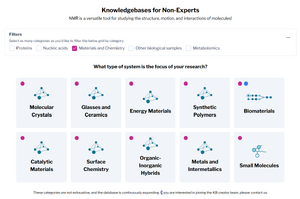Knowledgebases for Non-Experts: Difference between revisions
From Network for Advanced NMR
Jump to navigationJump to search
Mmaciejewski (talk | contribs) No edit summary |
Mmaciejewski (talk | contribs) No edit summary |
||
| Line 12: | Line 12: | ||
== Content Areas == | == Content Areas == | ||
The table below shows the Content Areas separated by their | Each Knowledgebase for Non-Experts is organized into '''Content Areas''', which serve as the primary hubs for exploring how NMR can be applied to specific types of samples or scientific questions. | ||
The table below shows the '''Content Areas''' separated by their '''Categories.''' | |||
If you would like to contribute to these KB Content Areas, please reach out to any of the [https://usnan.org/about/contacts NAN contacts] | |||
{| class="wikitable" | {| class="wikitable" | ||
! Proteins !! Nucleic Acids !! Materials and Chemistry !! Metabolomics !! Other Biological Samples | ! Proteins !! Nucleic Acids !! Materials and Chemistry !! Metabolomics !! Other Biological Samples | ||
| Line 36: | Line 40: | ||
| || || Small Molecules || || | | || || Small Molecules || || | ||
|} | |} | ||
=== Structure of a Content Area === | === Structure of a Content Area === | ||
* Each Content Area is composed of a series of '''tabs''' across the top of the page. | * Each Content Area is composed of a series of '''tabs''' across the top of the page. | ||
** Every Content Area includes a tab titled '''Introduction''' | ** Every Content Area includes a tab titled '''Introduction''' | ||
| Line 56: | Line 54: | ||
* '''HTML blurb''' | * '''HTML blurb''' | ||
** Provides | ** Provides a narrative related to the topic | ||
* '''Links to primary citations''' | * '''Links to primary citations''' | ||
** Key references relevant to the scientific subject | ** Key references relevant to the scientific subject | ||
| Line 64: | Line 62: | ||
* '''Links to related KB datasets''' | * '''Links to related KB datasets''' | ||
** Direct access to experimental datasets that are well vetted and connected to the subject matter | ** Direct access to experimental datasets that are well vetted and connected to the subject matter | ||
* ''' | * '''Image''' | ||
** A representative figure or illustration | ** A representative figure or illustration | ||
Revision as of 16:02, 17 June 2025
Overview

KBs for Non-Experts are organized into Content Areas, with each content area belonging to one or more filterable high-level categories
Categories
- Proteins
- Nucleic Acids
- Materials and Chemistry
- Metabolomics
- Other Biological Samples
Content Areas
Each Knowledgebase for Non-Experts is organized into Content Areas, which serve as the primary hubs for exploring how NMR can be applied to specific types of samples or scientific questions.
The table below shows the Content Areas separated by their Categories.
If you would like to contribute to these KB Content Areas, please reach out to any of the NAN contacts
| Proteins | Nucleic Acids | Materials and Chemistry | Metabolomics | Other Biological Samples |
|---|---|---|---|---|
| Intrinsically Disordered Proteins | DNA | Molecular Crystals | Biomarkers | Biomaterials |
| Soluble Proteins | RNA | Glasses and Ceramics | Flux | Carbohydrates |
| Fibrils and Polymeric Proteins | Energy Materials | Compound Identification | Natural Products | |
| Membrane Proteins | Synthetic Polymers | Systems Biology | ||
| Ligand Binding | Biomaterials | |||
| Catalytic Materials | ||||
| Surface Chemistry | ||||
| Organic-Inorganic Hybrids | ||||
| Metals and Intermetallics | ||||
| Small Molecules |
Structure of a Content Area
- Each Content Area is composed of a series of tabs across the top of the page.
- Every Content Area includes a tab titled Introduction
- Some Content Areas also include a tab titled What's right for you?
- This tab walks users through a decision tree to help them determine:
- If their system is suitable for NMR study
- What types of NMR experiments are appropriate for their needs
- This tab walks users through a decision tree to help them determine:
Components of Each Tab
Each tab may contain the following elements:
- HTML blurb
- Provides a narrative related to the topic
- Links to primary citations
- Key references relevant to the scientific subject
- Links to related vignettes
- Content vignettes – supplementary pages with in-depth information that does not fit within the main tab layout
- Literature vignettes – concise summaries of published studies where the topic played a central role
- Links to related KB datasets
- Direct access to experimental datasets that are well vetted and connected to the subject matter
- Image
- A representative figure or illustration